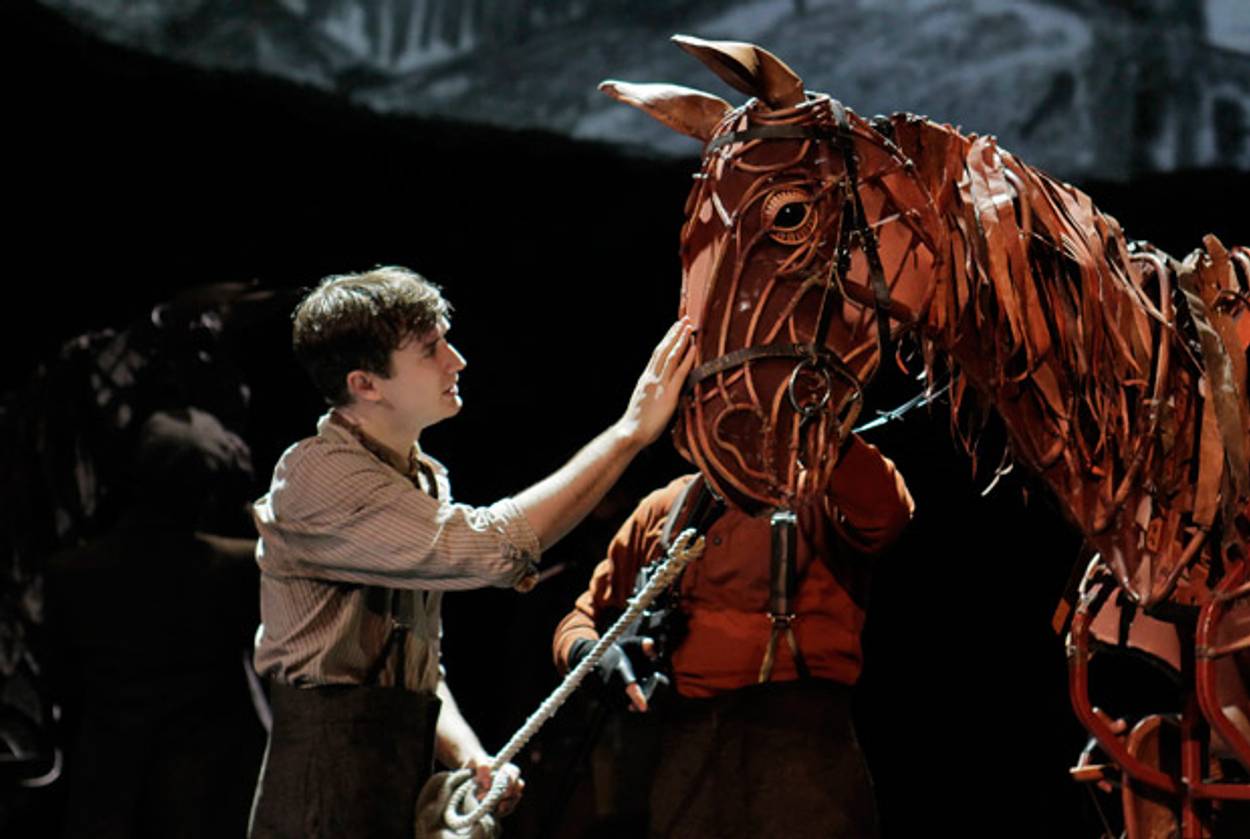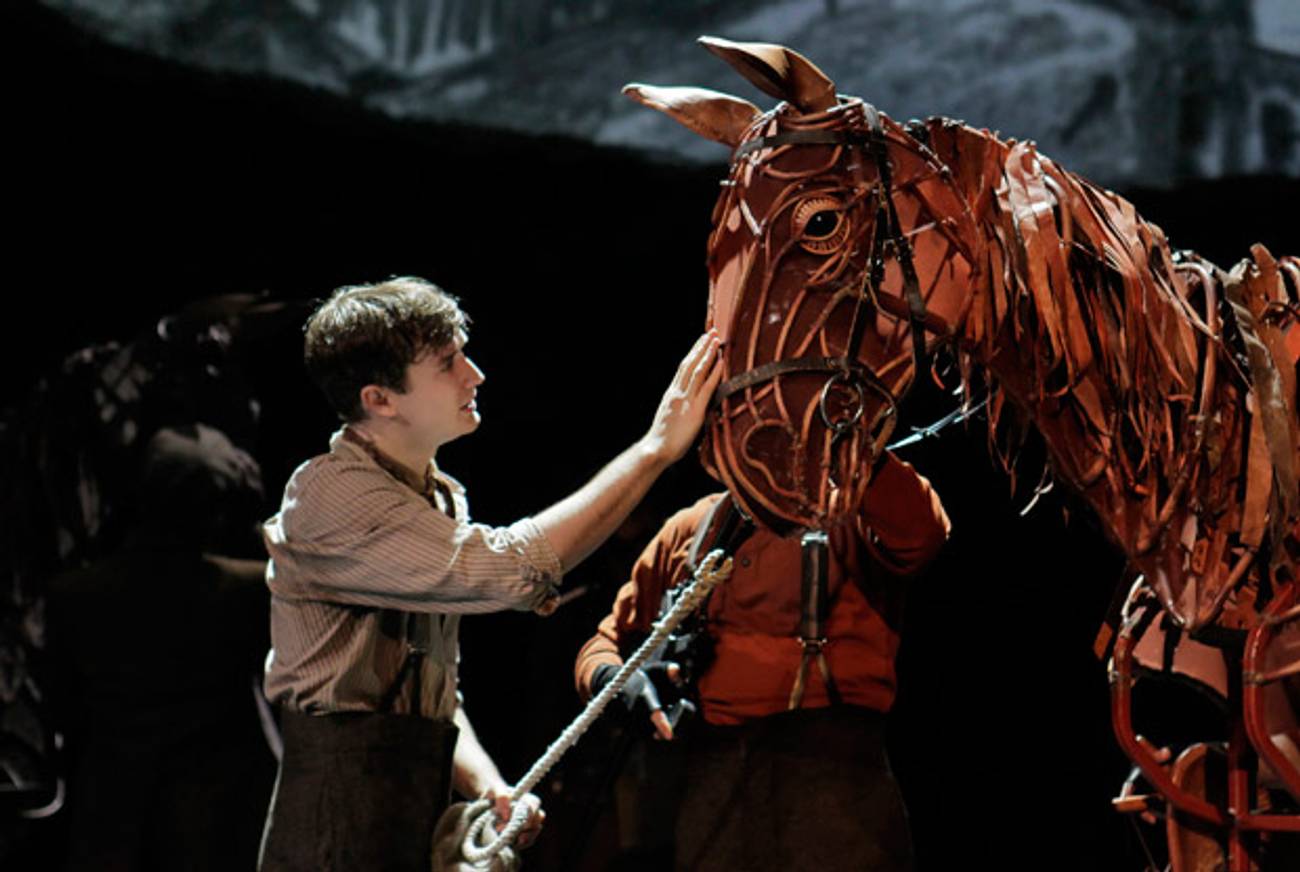They Shoot Horses
Steven Spielberg’s film adaptation of War Horse saps the imaginative power of the play in favor of sentimentality




How many horses does it take to make a War Horse? Film icon Steven Spielberg reportedly used 14 different horses to portray Joey, the main character of the film version of Michael Morpurgo’s 1982 children’s novel about the bond between a horse and the boy who owns him, the price of courage, and the horrors of war. By contrast, there are no horses in the stage version of the same saga, which, fortunately, is still playing at New York’s Vivian Beaumont Theater at Lincoln Center. But the theatrical Joey, a heart-throb of a puppet manipulated by three first-class actors inside an equine frame, is far more memorable than all the stallions of Arabia, or the 280 horses that Steven Spielberg was said to have used in a single scene of his schmaltzy, sweeping epic—a Gone With the Wind for children and perhaps horses.
If you live anywhere near New York City, save the money you might have spent on popcorn and the film rendition of War Horse, which galloped into movie theaters just in time for the predictable Oscar nominations. Race out instead to catch the play, which won five Tony awards in 2011, including best play.
Seeing the play and the film in close proximity reminds us of the magic that great theater can create, as opposed to most expensive, even well-crafted movies. Why are we moved more by the plight of a horse puppet than by a snorting and bucking horse in the flesh? The answer lies in the transformative power of theater, which, like great literature, stirs the imagination.
This Broadway play is everything that the Hollywood movie is not. The play is gritty, clear, nuanced, deeply moving, and intensely anti-war. “Here’s what war did,” wrote the book’s author, Morpurgo. “It burned flesh. It killed my uncle. It made my mother weep.” Its film counterpart allows that war may be noisy and dangerous but remains somehow noble. Good and bad people die in the play. In Spielberg’s saga, almost no one dies. While the play is ambitious and majestic, Spielberg’s War Horse is sentimental schlock—which is what this talented, skilled narrator has increasingly been dishing out of late.
The genius of the play is not the plot. National Velvet, the 1944 Liz Taylor vehicle, had more twists and subtlety. War Horse is, after all, a children’s fable, set in Devon, England, just prior to the outbreak of World War I. The story is fairly straightforward: Boy meets horse as newborn foal; boy falls for horse, whom he names Joey; boy tames and trains horse to pull a plow, something that Joey, a thoroughbred, was not born to do; boy loses horse to World War I conscription; boy goes off to war in search of horse. (You will have to see the play to learn if boy and horse survive and are reunited.)
The stage play is brilliantly adapted from the book by Nick Stafford in association with the Handspring Puppet Company. Its human characters are real. Their cruelty and flaws and the pain they inflict, deliberately and unconsciously, are poignantly evoked by a magnificent cast, directed with finesse and discipline by Marianne Elliott and Tom Morris, with Toby Sedgwick providing what is called “horse choreography.” Particularly memorable is Boris McGiver, as Ted Narracott, the stubbornly proud, often inadvertently cruel father of Seth Numrich, who stars as son Albert. In one of many drunken moments, Ted nearly loses the family farm by buying the thoroughbred colt instead of the plow horse the family needs just to one-up his well-to-do brother. Later on, he sneaks out of his house to sell his son’s beloved horse into cavalry service to stave off having to lose the family farm. The Narracott family’s desperation, of course, is born of Ted’s drinking, his foolish pride, and crushing poverty. Numrich gives a powerful performance as young Albert, whom we see transformed from an innocent boy into an agile young man and then into a somewhat hapless soldier whose devotion to his horse often seems stronger than to his drunken father, his family, or his country. Who can blame him? The British and German soldiers in this play are not archetypes, but complex characters, some of whom love horses and their fellow men, and others who relish brutalizing them.
In a uniformly superb cast, Peter Hermann gives a particularly stirring performance as Friedrich Muller, a German soldier who assumes a dead medical officer’s identity to save himself and Joey from having to go to the front and almost certain death. There is no glory or flag-waving in this play, and virtually no politics, just a desire by man and beast alike to survive. We are reminded that this was the world’s longest and most pointless of conflicts, in which an estimated 17 million soldiers and civilians, not to mention millions of horses, died.
In one particularly vivid scene, Joey confronts the future’s iron horse—the merciless tank, portrayed as lines drawn on a screen, against which the puppet horse rears pathetically, a portent of a century of mechanized wars to come.
Though a child’s story, War Horse is no play for children. Only at its conclusion does the play succumb to a childlike desire for happy endings. Not so the movie version. Spielberg stands the play’s anti-war message on its head. The British countryside has never looked so green or beautiful. There are sweeping panoramic shots of the fields and hills straight out of The Sound of Music and How Green Was My Valley. Spielberg never shows the grinding poverty of the play’s Narracott farm, or the desperate struggle to put food on the table and pay the rent. Even his occasionally arresting depiction of the guts, gore, and gas of trench warfare, the true horrors of World War I, has soft edges. His characters are more caricatures than people; Ted Narracott, for instance, is a sweet, well-intentioned drunken ex war-hero, not the play’s blustering, irresponsible wreck of a man whose alcoholism repeatedly threatens his family with ruin.
Almost no one dies in the movie version. And those who do are such thinly drawn caricatures that it is almost impossible to mourn their passing. Amazingly, all the characters speak marvelous English with country-appropriate accents—the two German boys who are shot rather offhandedly for desertion; a young French girl with an ill-defined illness; her doting, jam-making philosopher grandfather; the Germans who raid their farm. The one death that has dramatic punch is that of Topthorn, a huge black stallion whom Joey befriends at war. Topthorn is literally worked to death, starved and exhausted by pulling ambulances and finally artillery up muddy hills.
The most dramatic moment in both the play and the film is Joey’s frantic bolt for freedom through a bleak, battle-scarred no-man’s land, where he eventually entangles himself in ribbons of barbed wire that drag him down and nearly kill him. This is vintage Spielberg (but once again, more creatively portrayed on stage). But even this moving moment of true pathos is followed by a dud of a scene—an unconvincing truce between Germans and the English as a soldier from each side rises from his mud-filled trench to help free poor Joey from the wire. (In Spielberg’s production, we are quickly assured, the wire was made of rubber so that no horses would be harmed in production. Ditto, the wounds on the horses, which were the work of the film’s makeup artists—or, as they appear in the credits, the film’s “equine hair and make-up” unit.) But such episodes are few and far between in this seemingly endless, 146-minute epic, whose sentimentality is reinforced by John Williams’ sumptuous, omnipresent score, which swells over farms, fields, and battlefields. The play, by contrast, uses folk tunes mainly as punctuation.
There is plenty of what film buffs call “homage” in this Spielberg saga. An overhead shot of human and horse corpses littering the battlefield as the camera pans the scene of slaughter seems straight out of Gone With The Wind. Rememberthe iconic scene of the dead and dying in Atlanta’s railway station? So, too, is Spielberg’s shot of a hill overlooking the Narracott family farm as three main characters embrace in silhouette against a bright orange, Technicolor sky. Oh to be at Tara! Or, back at the Beaumont, or for that matter, just about anyplace else.
Judith Miller, Tablet Magazine’s theater critic, is the author of the memoir The Story: A Reporter’s Journey.
Judith Miller, Tablet Magazine’s theater critic, is a former New York Times Cairo bureau chief and investigative reporter. She is also the author of the memoir The Story: A Reporter’s Journey.